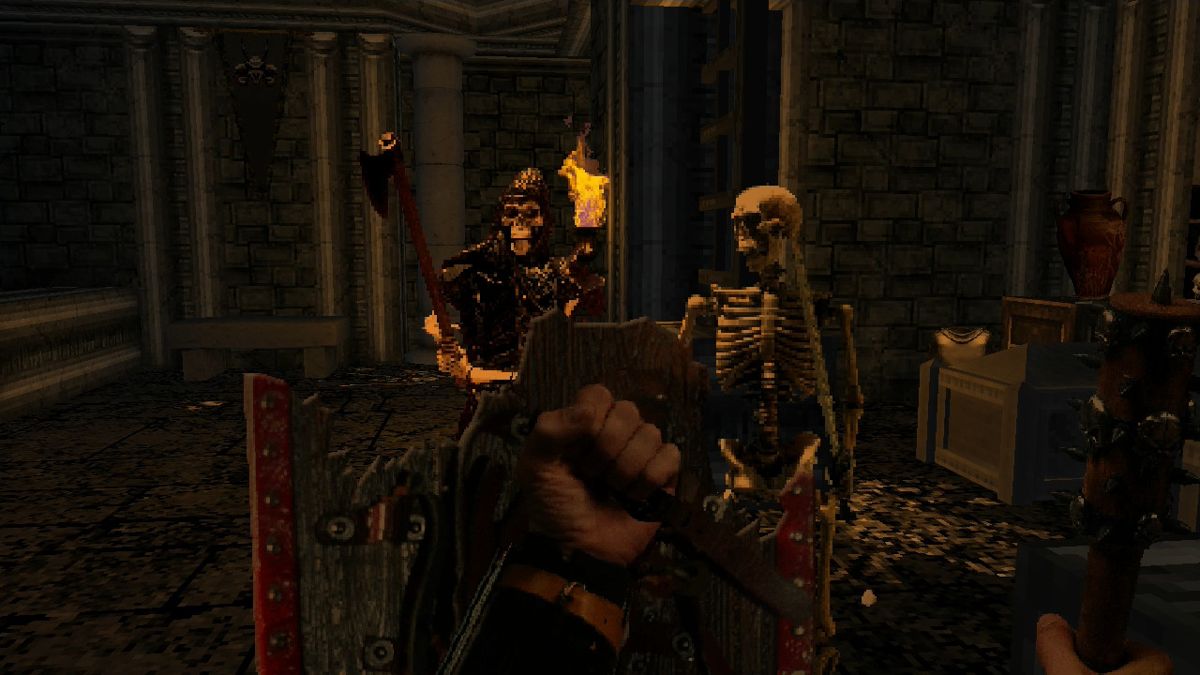Despite its title, Arthurian Legends doesn't really have a huge amount to do with Arthurian legend, but it does include a little bit of backstory that refers to Uther Pendragon, Merlin, and Igraine but backstory is all it is. You start the game and are greeted with men breaking into your house to kill you, so off you go. You don't meet Uther, or Merlin, or anyone else associated with the legends. Just a bunch of armored men, wizards, and hell creatures, all of whom need killing. Essentially, the story is that you're a one-man army fending off an invasion by devil-worshipping Saxons.
The game is an FPS that greatly takes after Witchaven in that it emphasizes melee combat while including the use of magical runes and potions. Despite being created by a one-man studio, Scolaro Games (Keith Scolaro), it's actually a general improvement on Witchaven. The combat is more complex and provides more of a sense of feedback than most melee FPSs. You can actively block with a shield, perform a shield bash to stun enemies, or use an extra weapon in your left hand if you prefer, and there's a better sense of attacks connecting through enemy reactions, sound effects, and blood spraying everywhere. It's an amusingly gross game - even using the crossbow, enemies will literally explode upon death, leaving behind a pool of gore and a a decapitated head that you can kick around a bit.
The setting is dark and grim, but there is a sense of humor running through the game that takes after classic FPSs, particularly the Build engine classics, and Monty Python and the Holy Grail. Visually, it resembles Build engine games in its sense of verticality but it lacks that engine's capability for reshaping the environment mid-level. Scolaro made the game using a program called 001 Game Creator, one of those "game design for rookies" programs, which makes the completed game even more impressive because it certainly appears that Scolaro pushed the engine as far as it could possibly go. The graphics are clear, easy to parse at a glance, and about on par with mid-90s 2D FPSs. The soundscape is somewhat inconsistent, which is common with indie games. Some enemies will speak up but it's not unusual for them to sneak up on you completely silent. Unfortunately, the low-budget indie nature of the game becomes apparent with the kinds of bugs that occur, particularly in corrupted saved games that get more common in the game's later stages.
Basic enemies include various types of enemy soldiers who gradually give way to giant spiders, undead skeletons (these guys again...), two-headed wolves, and flying imps. At the end of each episode, you have to face a boss enemy that is an evil witch or wizard, and there are occasional mid-episode bosses who are mostly optional, such as the Green Knight, the Questing Beast, and...the Killer Rabbit (make sure you save one of your holy hand grenades for that one).
Much like Witchaven, weapons and armor degrade through use, and the game encourages you to switch among them often because of "ammo" shortages; e.g., the spiked club is great for stunning magic users and the grenades are great for when you're being mobbed, but you really should save them for such occasions.
Supplemental reading: The Dragon Lord, by David Drake






No comments:
Post a Comment